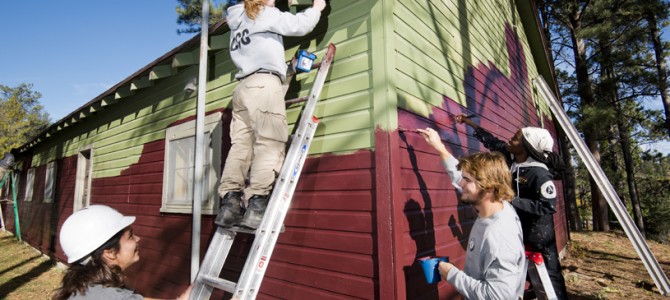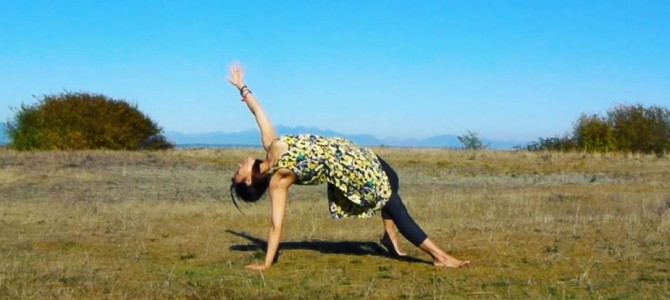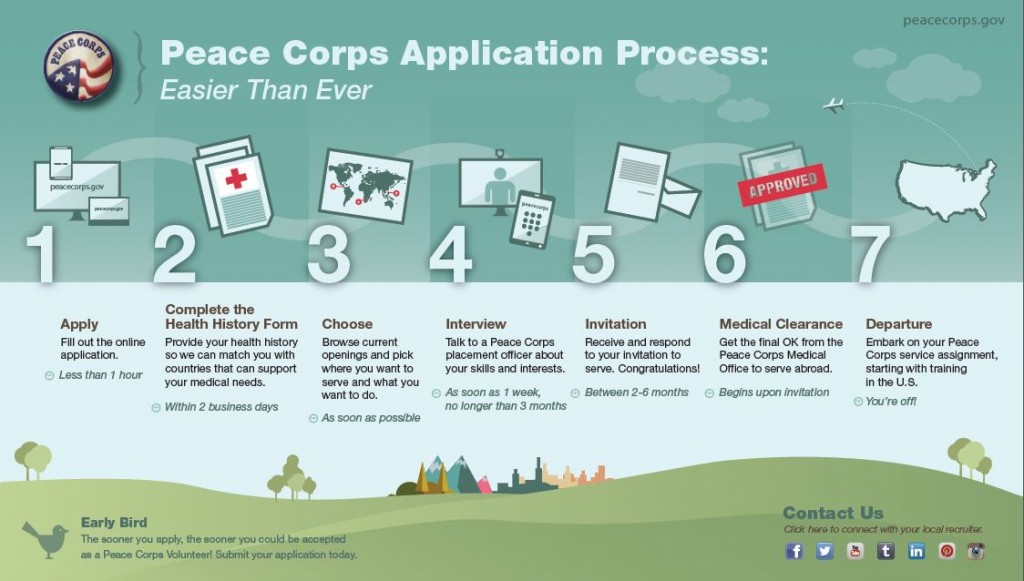Elizabeth Barrett is a licensed marriage and family therapist who is concerned with our current approach to mental health in this country. She is also a huge advocate for the national service movement. In fact, if you are one of her students at Cal Poly and you ask for a letter of recommendation, she will most likely tell you to come back after doing a year of service. Could national service be a solution to the overwhelming pressure, anxiety and disconnection many young people face? Listen into our conversation and check out Elizabeth’s article in the Huffington Post.
I frequently meet students looking to become social entrepreneurs after they graduate. They are seduced by the idea of freedom, making a difference and not having “vacation days.” When I meet these students I often ask, “What is your big idea?” I am responded to with a shrug, indicating they will figure it out once they get real world experience. Used to hearing more traditional advice like get an MBA or work in consulting, they are surprised when I suggest a year of service with a program like AmeriCorps.
How can serving in the nonprofit sector prepare you for the day when you start a business?
1. Expand Your Ability to Serve
Customer service is the new marketing. With the rise of social media platforms and comment boards, every brand is subject to word-of-mouth affecting sales. The most successful companies are those who treat their customers with a heart of service. What better way to understand service then to spend a year working in the nonprofit/social services sector?
2. Learn to Make Money go Far
Projection Hub recently gave a break down on how start-ups are funded. They noted that 34 percent are bootstrapped, literally funded off the founders’ personal savings. Translation: founders have little to no paycheck for at least a few months during the startup phase. And for founders operating on borrowed money, salaries tend to be skimpy early on while investors wait for proof of concept.
To work at a startup, you must be able to create and market products on a shoestring while also living on a minimal salary. Service year programs, like AmeriCorps and Peace Corps, offer you the opportunity to live on a stipend (enough money to cover room and board). Service members are placed to work at nonprofits. That role gives you the opportunity to practice creative ways to market and provide services with out spending money.
Founders coming off of a term of service are already equipped to bootstrap their new startup.
3. Selling an Intangible
Being effective at sales takes practice. People often think that because most nonprofits are not product based and discounted services that there is no selling. In fact the opposite is true. Nonprofits are funded by donations and grants, meaning that the staff are responsible for selling an idea or vision. Wendy Kopp funded Teach For America by selling the idea, “One day all children in this nation will have the opportunity to attain an excellent education.” Yup, people gave her money and the only thing they got in return was a tax donation receipt and the knowledge that they are part of something great. This is not much different than when an investor writes a check for your half-baked app idea that has not even been built or market tested. If you want to start a business, you better know how to sell an idea.
4. Long Job Descriptions
82 percent of nonprofits with a staff have 1-10 employees. This means there are 1-10 people trying to take on the mission of ending homelessness in their town, raising the reading level of every child in a low-income school district, providing a safe place for all the victims of domestic violence in a zip code. To execute on these missions, each staff member (and service year member) must take on multiple roles spanning from events planning to marketing to administration. This is similar to when a founder starts a company. On paper, they are a CEO, but they are also the accountant, the data-entry specialist and the blogger. It is important to be able to learn skills fast and be able to switch between roles if you want to work in the startup world.
5. Family Style Workplace
Both nonprofits and startups tend to have tight-knit teams that are inspired by passion. They work together on the weekend and grueling late nights. Co-workers know who you are dating and when your father is in the hospital. They are like family. This type of work environment can come with challenges and drama. It is important to learn how to navigate these types of relationships sooner rather then later.
Real Service Alumni Running Social Enterprises
Meet 20 social entrepreneurs that started their career with a year of service on next week’s Journey to Social Entrepreneurship Virtual Summit. We are connecting with alumni from Peace Corps, AmeriCorps, City Year and Teach for America who leveraged the skills learned in their term of service to launch a start up that is working to solve today’s complex issues.
Register for your free spot today.
By Anna Lenhart
Founder, Next Generation of Service
Founder, Anani Cloud Solutions
Past employee of 3 start-ups
AmeriCorps Alum ![]()
Where Do We Find Inspiration?
At the Next Generation of Service, we pair students and recent graduates with peer guides that educate and encourage national service. We start this process with our intake form where we ask, “What Inspires You?” This year we have had over 100 students tell us about their sources of inspiration. We’ve noticed that while we’re all inspired in different ways, there are several common areas that many of us draw upon.
Here are the top 5 sources for inspiration:
1. People Who Overcome Adversity
Everyone loves a good underdog story, so when you are feeling uninspired, revisit your favorite (I really like Disney’s Big Green). Take the time to reflect on the adversity in your life; we’ve all faced challenges and grown from them. What is something you have overcome to get to where you are?
2. Making a Difference
It is inspiring and empowering to feel like we can change aspects of our world for the better. Think about the things you want to change, the issues you care about, and look for organizations or thought leaders working to address those issues. Follow these organizations on social media and consider supporting their work through donations or by volunteering.
3. Family
Our family can be a source of stress at times but also a major source of strength. What you consider family is likely the group of people that know you best — that cherish you, that you cherish in return. At the end of the day, your family is there to support you throughout your journey and to succeed, and that is inspiring.
We often hear stories of students inspired by parents who faced challenges or family members with certain career paths. Our family serves as the primary influence on our values and worldviews. As we grow, we are able to internalize, test and reject these values. At NGS, we hope you build upon the foundation your family has helped foster and achieve personal growth through working with others.
4. Art
Humans seem destined to create – to channel their passions into things we can see, hear, and feel. Some would argue that the purpose of art is to inspire – to inspire action or contemplation. Each of us responds to art in different ways, which is truly the beauty of art.
When was the last time you went to your local museum or high school play? Where is the art in your own backyard?
Here are some examples of individuals using art to inspire social change.
5. Teachers & Mentors
A great teacher works not only to create captivating and timely curriculum aimed at teaching you critical thinking skills but also to change you and help you develop a sense of purpose. You might not remember those ideas or facts your teachers taught you, but you will remember those experiences that made you feel inspired.
Teachers help guide you in self-discovery through providing opportunities for collaboration, to overcome challenges and to make connections in the world. Along the way, they instill a sense of ability and worth in the student. It is no wonder teachers are commonly listed as a source of inspiration, and also that many of our service opportunities involve teaching others.
By Jessica Tang
Four years ago, when I first started teaching yoga, I always aspired for the one day when I can be like this teacher or that teacher and have my own following. I wanted to be a leader, and to me, these teachers were leaders because they had followers. At that time, leadership to me meant being in a position of power, having a “management” role, or having a large following. Although there is no definitive answer to what leadership is, I learned over the past few years that leadership has less to do with your job title or the amount of followers you have. Rather, it is related to how much you inspire and motivate not just other people, but yourself.
Right out of teacher training, I experienced a steep learning curve in finding my own voice as a teacher. The words with which I led class were my teacher’s words. And despite the number of different classes I took to learn from other teachers, I found myself feeling like an echo or a shadow of someone else. As I taught more classes, my knowledge grew, but I felt lost at the same time. Confused as to what my own voice sounds like, another voice started developing in my head — the voice of doubt.
When it comes to my own voice of doubt, it usually comes in the forms of self-defeating statements and constant comparison. As much as I was learning from other teachers, I also found myself comparing my experience level to theirs. The dialogue of comparison soon turned to one of harsh statements that left me feeling small. Despite the positive feedback I received from students, I had a tough time letting go of the nagging internal dialogue that said I was not enough. This voice of doubt not only left me feeling defeated, but kept me from venturing outside the comfort zone I found in a particular studio.
One of my teacher friends once shared that we can’t truly be compassionate towards others until we learn to truly be compassionate towards ourselves. In Sanskrit, there is a term — ahimsa — that loosely translates to “do no harm,” “non-violence” or “compassion.” Although in my classes I taught students to practice compassion and non-judgment, it was paradoxical that my own internal dialogue towards myself was anything BUT gentle and kind. I eventually shared my insecurities with a coach who was also one of my students. In response, this is what she asked me:
If it were a friend who told you about the voice in her head that says “I am not enough,” what would you tell her?
I thought about this one for a second, and this was what I would have told my “friend:”
Come into a comfortable seat, and start to tune into your breath. Take a few deep inhales and exhales, letting go of anything you find that is weighing you down as you breath out through your mouth. Do this for about 5 cycles of breath. Now notice the thoughts running through your head. Without any judgments or labels on them as “good” or “bad,” ask yourself: “Are they true?”
After that meeting, I returned to the dialogue I would have told a friend every time I caught my mind chatter talking down on myself. Instead of teaching others what ahimsa means, I started practicing it too. The breath work practiced in yoga served as a tool for greater self-awareness and mindfulness. In turn, I realized that as much as it was important to share my teachings with students, it was also important to BE a student to my own inner teacher.
Similarly, leadership is not gained through having a certain title or by setting out how many followers one must have in order to be considered a leader. Inspiration is derived from living out our personal values and making choices that align with our inner truth. Beyond the physical practice, yoga teaches us that we each have our own style as leaders, teachers, etc. and most importantly, to always honor and lead with our inner truth.
Jessica is a yoga teacher from Vancouver, BC and recently started the project – Wanderlove Yoga – to share how yoga can be experienced anywhere, anytime. Off the mat, she loves exploring places and capturing moments on her camera.
When we start our career with service it is easy to get overwhelmed with the social issue at hand, to put all our energy into “fixing”- it is important to remember to breathe, to make space for our own growth and healing.
How long-term service encourages a freelance future
The Atlantic recently published an article titled the A World Without Work (read it here). In summary, as cashier, office clerk, and driver jobs are replaced with artificial intelligence (47% will be by 2050 according to the article) our society is predicted to veer off into a combination of two worlds. The first being massive unemployment and all the negative impacts of that: increased domestic violence, alcoholism and depression, a world where people sit in solitude on couches staring at screens that deliver movies and TV shows. The second is a world of self-employment, filled with communities of creatives, people who are civically engaged, build furniture, volunteer three days a week and trade crops for locally-sewn clothing.
I am left thinking about the role long-term service programs play in this new paradigm. I think of the journey my close friend Katie (also an AmeriCorps VISTA alum) and I have embarked upon. We both launched our freelance careers after our AmeriCorps experience, and the work we produced at our service locations remain significant projects in our portfolios, the nonprofits we served were in some ways the first domino in a cascade of clients.
It was a day, early in my year-long term as an AmeriCorps VISTA at Shakti Rising when the business development director approached me about this Salesforce CRM they had signed up for months ago, but she had not had the bandwidth to implement (I would come to learn this is a common dilemma amongst the nonprofit sector). I agreed to take a look having recently completed an entry to programing class. Implementing Salesforce became a nine month project and involved me clearing out the entire database 3 times and reimporting because I messed up the data architecture. Regardless after completing the project other NPOs in the area started asking me for help, and with a strong testimonial from Shakti Rising, I became a freelancer. The money I bring in from consulting at times is my sustaining income and at others is additional “side hustle” but one thing is for sure- I would not have the flexibility to operate NGS (a volunteer-led organization) without the consulting life style.
Katie has a similar story with her design freelance work (Golden Grouper). It has allowed her the flexibility to travel and help her husband with the operation of the Raptor Institute, an environmental education program. Katie and I are not the norm among AmeriCorps Alums, many work full-time jobs but I think we both recognize that the fast-paced, multi-facetted, creative problem solving roles we held during our service terms provided experience that made running our own business seem more manageable. And if, one day, there is a world without work those that have focused on service early in their career, I imagine will have the skills and wherewithal to choose the path of community and service.
Writen By Anna Lenhart
When we were young, failure was practically embedded in everything we did. A visit to the grocery store with your mom was practically a tour of life’s hazard warnings. From tripping on your shoelace, to dropping the carton of eggs, to distributing the correct amount of money to the cashier, we soaked in every experience like a sponge and your mother, too, encouraged it. Without the mistake, there was no opportunity for the lesson, no opportunity for growth.
Somewhere along the way, towards the path of adulthood, we became shameful of mistakes and as a result, held back. We took less chances. We stick strongly to what we know, to what seems familiar, and to what will predictably bring us success. Nowhere is this pattern seen more than in exploring new career choices or endeavours.
In a profit=success culture, volunteer work, as noble as it may seem, may be viewed as a ‘failure’ by those around us. Often times, we value the work that we do or our chosen career path by the salary attached. “What do you do?” is often not a question of “What are you passionate about?” but “How do you choose to make money?” This is the way many of our understandings around the work force goes. The very decision to be of service, to accept no monetary reward, can be seen as “time wasted.”
It is here, in this uncomfortable space
Of course, there are the few that embrace mistakes, thrive off of new experiences and view challenges as opportunities for growth. One of those individuals is Chris Guillebeau, an entrepreneur who found a way to use his seemingly selfish passion in service of his greater community. In 2012, Guillebeau’s desire to travel to every country in the world left him wondering how, and if it was even possible at all to create a bridge between his goal and the rest of the world. With a little creativity and a lot of experimenting, he did.
Guillebeau’s story is not of the rare kind, though we rarely hear about it. It is not common to hear about small scale heroes who choose people over profit
Written by Anja Jerkovic
Cover Photo: World Domination Summit World Record Waffle Breakfast, beds donated to Portland families. Photo by Armosa Studios
This year Peace Corps completely revamped their application process! What does this mean for you? It means the notoriously cumbersome Peace Corps application can now be completed in about 1 hour, making the legendary program as competitive as some of the top jobs in the country. Check out our tips as you embark on the application process.
1. Talk to a recruiter
You know how your high school counselor told you to visit university campuses and meet with their admissions office? Well, if you’re interested in Peace Corps programs, we suggest you meet with your local Peace Corps recruiter for the most up-to-date, official program information. You can find one here. If you identify as LBGT and want more info on what it is like to serve in the Peace Corps, check out lbgtrpcv.org.
2. Time Your Program
The majority of Peace Corps programs commence in late spring/early summer (after most students graduate). Positions tend to be posted 7-9 months prior to departure and are updated about every 3 months. This means the majority of positions will be posted between September and November, so plan ahead.
3. Brows Positions
The Peace Corps admission team wants to see that you did your research (this is a good tip for all professional applications). Take the time to look through the database of positions and consider the locations, focus areas (education, health, etc.) and even specific titles (e.g., Primary Education English Teacher) that fit your goals and preferences. In the second stage of your application, you will indicate the programs you are interested in. DO NOT select a region with a focus area that does not have any open positions. For example, if you are interested in education and living in Colombia, but Colombia does not have any open teaching positions, do not mark “Location: Colombia, Focus: Education.” This oversight in matching open opportunities to your preferences will affect consideration of your application.
4. Be Open
The application will allow you to list 3 preferred locations/focus areas. Broadening your preferences (i.e., all of sub-Saharan Africa), the larger the pool of available positions available to you. With this said, if you select “Anywhere needed,” be prepared to be sent ANYWHERE. Also, keep in mind there is an additional comments box; this is a great place to mention any exceptions in your preferences, and to demonstrate that you considered all of your options. You could say: “I am open to going anywhere as long as it never drops below negative 10 degrees Celsius. Thus, the teaching positions in East Asia are my top choices.”
5. Make Sure That You Can Handle It
Know that the Peace Corps is not for everyone. Be realistic in your preferences and your goals, and your commitment to the opportunity. The best candidates should possess a sense of adventure and a willingness to learn. And you had better be up for your restroom being a hole in the ground, which may or may not be inhabited by snakes (speaking from experience here). Every position in the Peace Corps database contains a “Living Conditions” section; read it, then imagine yourself in that environment. Do you look happy? If so, great! If not, the NGS guides are available to talk you through the decision process and the alternatives to Peace Corps. Sign up for a one-on-one session with a NGS guide here.
Sign-up for a One-on-one Session
To all the RPCVs out there feel free to add your tips bellow!
Happy World Music Day! Making the choice to venture down a career path as a change maker dedicated to service – and living it – is not always easy. Some days, we just need to jam out. And maybe dance a little… Here are some of our favorite songs that keep me inspired:
Aloe Blacc- Wake Me Up
I tried carrying the weight of the world
But I only have two hands
Hope I get the chance to travel the world
But I don’t have any plans
Hanson- World’s On Fire
(2009)- yes they started making good music when they became adults ![]()
Tracy Chapman – “Talkin’ About A Revolution”
While they’re standing in the welfare lines
Crying at the doorsteps of those armies of salvation
“You Get What You Give” – New Radicals
This whole damn world, could fall apart
You’ll be ok, follow your heart
You’re in harms way, I’m right behind
Now say you’re mine
You’ve got the music in you
Don’t let go
You’ve got the music in you
One dance left
This world is gonna pull through
Don’t give up
You’ve got a reason to live
Can’t forget
We only get what we give
“You Gotta Be” – Des’ree
Listen as your day unfolds, challenge what the future holds
Try and keep your head up to the sky
Lovers, they may cause you tears
Go ahead release your fears, stand up and be counted
Don’t be ashamed to cry
You gotta be
You gotta be bad, you gotta be bold, you gotta be wiser
You gotta be hard, you gotta be tough, you gotta be stronger
You gotta be cool, you gotta be calm, you gotta stay together
All I know, all I know, love will save the day
Last week I spent 5 days and 4 nights trekking through 38 miles of meandering, rocky terrain in the Grand Canyon. I survived off the 25 pounds of food and gear in my beat-up pack. Each day consisted of trying to reach our next “destination” (a plot of land that could fit 2 small tents) with enough water to turn our dehydrated food into a meal. I agreed to this adventure to prove to myself that I could live simply, off only what I can carry and most importantly away from all electronic devices (headlamp not included).
While walking, I could hardly comprehend the imagery flooding into my brain. It felt unreal. Shades of purple, brown and green streamed in infinite lines throughout the rocks above, below, behind, in front. Unreal. In one 48-hour time span, the only Homo sapiens I encountered were my group mates. Unreal.
I was overwhelmed with awe, and with fear. It wasn’t the “I’m-sitting-on-the-top-of-a-rollercoaster” kind of fear, but a more unnerving, “I ‘m-at-the-mercy-of-this-planet” kind of fear. I was humbled and empowered in the same instance; teetering on the edge faith and worry, and having to choose between them in every moment. It was by far one of the most profound experiences of my life. Profound in a way that complements my work as an activist and civil servant.
On my drive home to San Diego the day after climbing out of the “big ditch,” I caught up on one of my favorite podcasts. As I listened to “The Threshold Moment” episode of The Dirtbag Diaries, I began to cry. The podcast is the story of Kevin Fedarko’s (activist and author of the Emerald Mile) decade-long relationship with the Grand Canyon, and his work to protect this place.
With my own experience of the Grand Canyon fresh in my mind, I learned that the town of Tusayan, located just outside the south entrance to the park, is considering the development of a shopping center near the South Rim. The infrastructure would demand so much water that the aquifers below the canyon would dry up, leaving the streams and springs dry – the same streams and springs that trickled into my water bottles and sustained me on my journey. It hit me that if this development goes through, future visitors would not be able to hike along the Tonto trail they way I had. They would either have to rush through the landscape, never stopping to rest or marvel, or carry 20+ pounds of water on their backs – no small feat.
I became enraged by this injustice. Would I be one of the last people to do this hike… Because of a mall? I started to wonder… what if I dropped everything and joined the fight? I could join the protests, host fundraisers…Then I looked at the road sign ahead: San Diego 286 Miles. And I remembered, I am going home. Home, where my life is full, and where my time is consumed by fighting for other causes I care for deeply.
Before feeling despair over my already packed schedule, I reflected on the fact that I am part of this movement, despite living 507 miles from the South Rim. For one, by applying for a permit and walking this trail I made a statement that this place matters. And when the politicians see the numbers, they will see one more person on the roster of people who care about preserving it.
On a grander scale, every time a young person decides to add a year of service to their career path, they begin their career in a way that builds empathy. I don’t know the leaders that are pushing for development in Tusavan, but I wonder what song they would be singing if they had served as an AmeriCorps VISTA at an Indian Reservation like Pine Ridge?
We might not be able to work on every cause we care about. Chances are high that there are too many, and not enough hours in the day. In my life, I am content to work for the few causes that intertwine most with my life, and then take some time to look at how my actions in every facet of my life ripple outward to affect change in other areas, indirectly. When I work for women’s empowerment and develop new national service positions I increase the chances that there will be more civically engaged adults and leaders who choose the environment and communities over profits.










